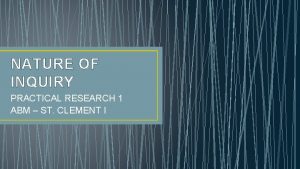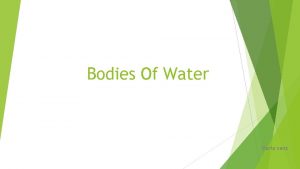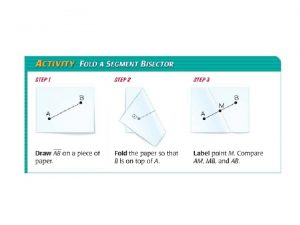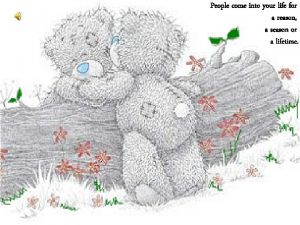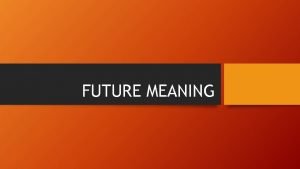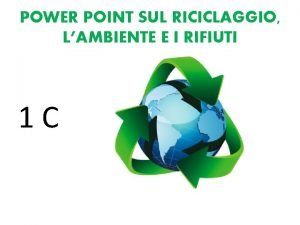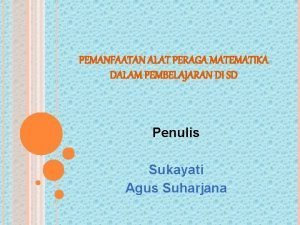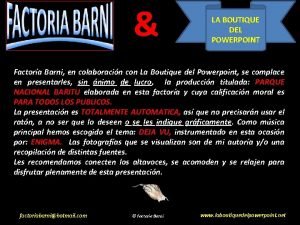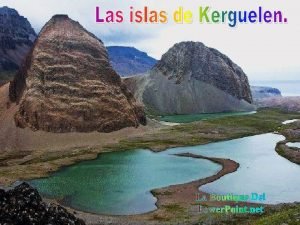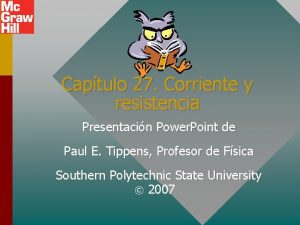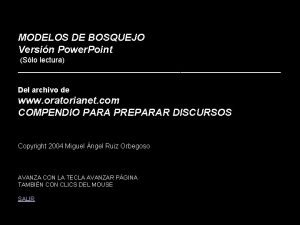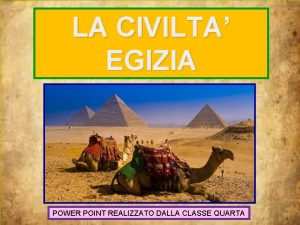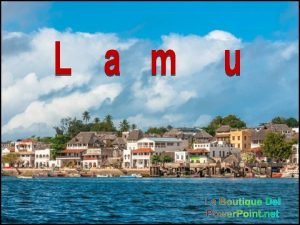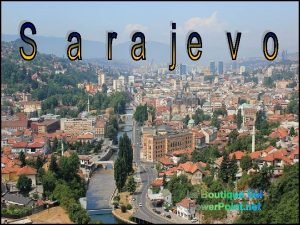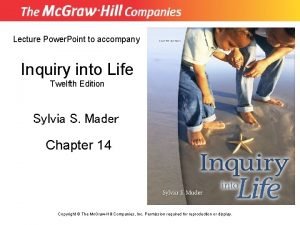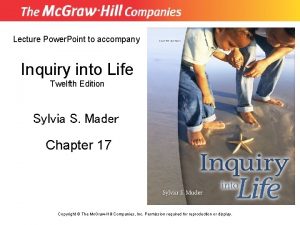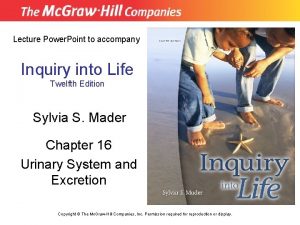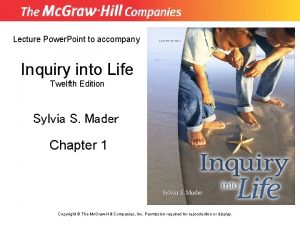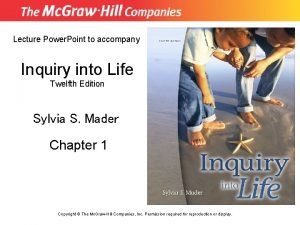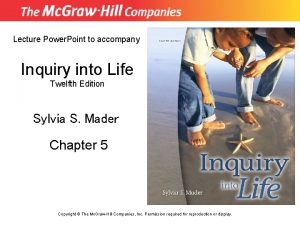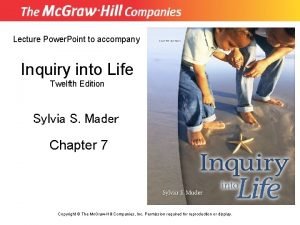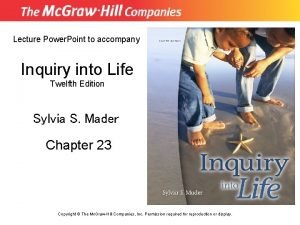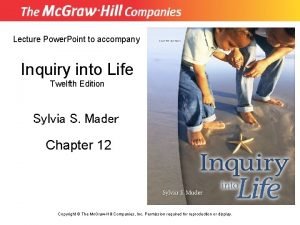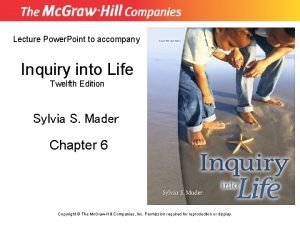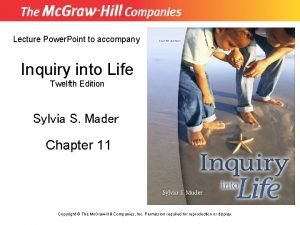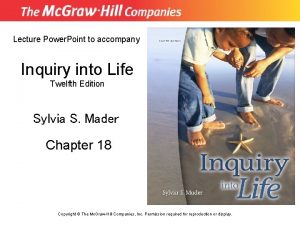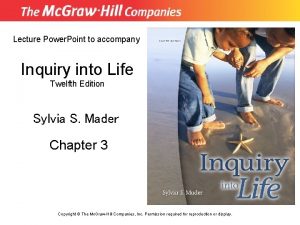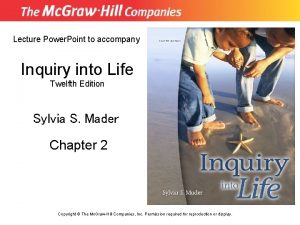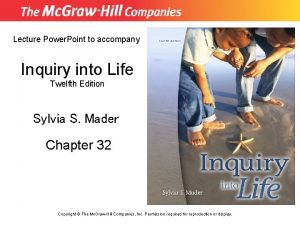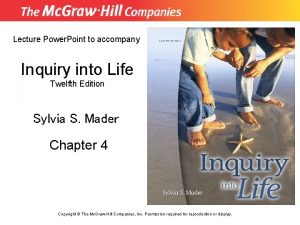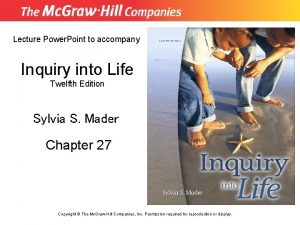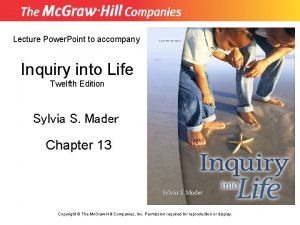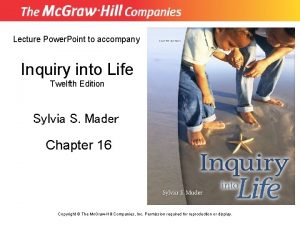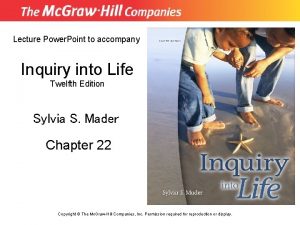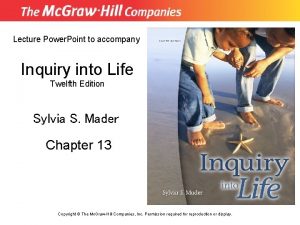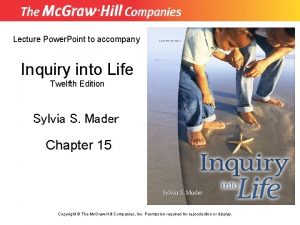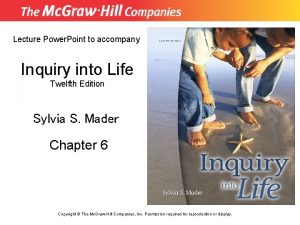Lecture Power Point to accompany Inquiry into Life




























































- Slides: 60

Lecture Power. Point to accompany Inquiry into Life Twelfth Edition Sylvia S. Mader Chapter 27 Copyright © The Mc. Graw-Hill Companies, Inc. Permission required for reproduction or display.

27. 1 Origin of Life • Age of Planet Earth - 4. 6 billion years • Oldest fossils - 3. 5 billion years • Possible Formation of the First Cells – Inorganic molecules reacted to form organic molecules – Organic molecules polymerized to become macromolecules – Plasma membrane formed – Protocells formed

Origin of the First Cell(s)

27. 1 Origin of Life • Evolution of Small Organic Molecules – Early life may have arose near the surface of the ocean – Miller and Urey Experiment (1953) • Formation of small organic molecules

27. 1 Origin of Life • Evolution of Small Organic Molecules – Some scientists hypothesize life began in hydrothermal vents deep in the ocean

27. 1 Origin of Life • Macromolecules – RNA-first Hypothesis • In some instances RNA can function as both a substrate and an enzyme • If RNA evolved first it could function as both genes and enzymes – Protein-first Hypothesis • Amino acids can form polypeptides when exposed to dry heat • Form microspheres when introduced back into water

27. 1 Origin of Life • Macromolecules – Cairnes-Smith hypothesis • Clay attracts small organic molecules and also contains iron and zinc • Iron and zinc may have served as inorganic catalysts for polypeptide formation • Clay also collects energy from radioactive decay and releases it under specific environmental conditions – Could have served as energy source for polymerization

27. 1 Origin of Life • The Protocell – Aleksandr Oparin’s experiments • Under specific conditions of p. H, ionic composition, and temperature concentrated mixtures of macromolecules form coacervates – Coacervate droplets absorb and incorporate many substances – May form a semi permeable boundary around droplet – In lipid environment, phospholipids are known to automatically form liposomes-may be the way plasma membranes first formed

27. 1 Origin of Life • The Heterotroph Hypothesis – Nutrition was plentiful in the ocean – Protocells were most likely heterotrophs • Implies that heterotrophs preceded autotrophs – Protocells probably used preformed ATP at first • Natural selection favored those that could extract ATP from carbohydrates • Fermentative process because oxygen was not available

27. 1 Origin of Life • The True Cell – Membrane-bounded structure that can produce proteins (enzymes) that allow DNA replication • DNA RNA Protein – RNA-first hypothesis suggests that RNA developed before DNA, so first true cell would have had RNA genes • Some viruses have RNA genes • Reverse transcriptase produces DNA from RNA • Suggests a mechanism as to how cells evolved to have DNA genes

27. 1 Origin of Life • The True Cell – Protein-first hypothesis suggest proteins evolved first • Complex enzymatic processes may have been necessary formation of DNA and RNA • Enzymes may have been needed to produce nucleotides and nucleic acids – The Cairnes-Smith hypothesis suggests RNA and protein evolved at the same time • RNA genes could replicate because proteins were already present to catalyze the reactions • But this supposes that two unlikely spontaneous processes would occur at once- formation of RNA and formation of protein

27. 1 Origin of Life • The True Cell – Once protocells had genes that could replicate, they became cells capable of reproducing, and biological evolution began.

27. 2 Evidence of Evolution • Evolution is the changes that have occurred in living organisms since the beginning of life. • Evolution is defined as “common descent” – Descent with modification

27. 2 Evidence of Evolution • Fossil Evidence – Hard body parts are preserved in most cases – Often embedded in sedimentary rock – Deposited in layers called strata • Each stratum is older than the one above and younger than the one below – Transitional fossils • Especially significant • Represent evolutionary links

Transitional Fossils

27. 2 Evidence of Evolution • Geological Timescale – History of Earth is divided into eras, then periods, and then epochs – Based on dating of fossil evidence • Relative Dating Method – Determines the relative order of fossils and strata but not the actual date • Absolute Method– Radioactive dating techniques are used to assign an actual date to a fossil – Technique is based on the half-life of radioactive isotopes


27. 2 Evidence of Evolution • Mass Extinctions – Large numbers of species become extinct in a short period of time • Remaining species may spread out and fill habitats left vacant – Five Major Extinctions have occurred • Earth may currently be experiencing a sixth mass extinction due to human activities

27. 2 Evidence of Evolution • Biogeographical Evidence – Biogeography is the study of the distribution of species throughout the world – The Earth has six biogeographical regions • Each has its own distinctive mix of species – Barriers prevented evolving species from migrating to other regions – Continental Drift • The positions of continents and oceans has shifted through time • The distribution of fossils and existing species allows us to determine approximate timeline

Continental Drift

27. 2 Evidence of Evolution • Anatomical Evidence – Common descent offers explanation for anatomical similarities • Homologous Structures – Same function and same basic structure, indicating a common ancestor – Ex: human arm and whale forelimb • Analogous Structures – Same basic function but different origins – Ex: wing of bird and wing of an insect • Vestigial Structures – Anatomical structures fully functional in one group and reduced, nonfunctional in another – Ex: Modern whales have a pelvic girdle and hind leg bones

Homologous Structures (insert figure 27. 8)

Homology Extends to Embryological Development

27. 2 Evidence of Evolution • Biochemical Evidence – All organisms use same basic biochemical molecules • DNA • ATP • Identical or nearly identical enzymes – Many developmental genes are shared – Degree of similarity between DNA base sequences and amino acid sequences indicates the degree of relatedness

Significance of Biochemical Differences

27. 3 The Process of Evolution • Evolution occurs at the population level – Genetic changes occur within a population – Microevolution: A change in gene frequencies within a population over time.

27. 3 The Process of Evolution • Population Genetics – Population- all members of a species occupying a particular area at the same time – Gene pool- the sum total of alleles of all genes in a population – Hardy and Weinberg used the binomial equation p 2+2 pq+q 2 to calculate the genotype and allele frequencies in a population

Calculating Gene Pool Frequencies Using the Hardy-Weinberg Equation

27. 3 The Process of Evolution • The data from the previous graphic shows that the next generation will have exactly the same ratio of genotypes as before:

27. 3 The Process of Evolution • The Hardy-Weinberg Principle – Allele frequencies in a gene pool will remain at equilibrium, thus constant, in each generation of a large sexually reproducing population as long as the following five conditions are met • • • No mutations No genetic drift No gene flow Random mating No selection – In real life these conditions are rarely met – Hardy-Weinberg law gives us a baseline by which to access whether or not evolution has occurred • Any change in allele frequencies indicates evolution

Microevolution

27. 3 The Process of Evolution • Five Agents of Evolutionary Change – Mutations • Only source of new alleles in a population • Can be an adaptive variation – Genetic Drift • Change in allele frequencies due to chance • Two main mechanisms – Founder Effect: a few individuals found a colony and their collective genes represent only a fraction of the original gene pool – Bottleneck Effect: population is subjected to near extinction by a disaster and so only a few genotypes contribute to next generation

Genetic Drift

Founder Effect

27. 3 The Process of Evolution • Five Agents of Evolutionary Change – Gene Flow • Movement of alleles between populations • Keeps the gene pools of two or more populations similar – Nonrandom Mating • Occurs when individuals pair up according to phenotype or genotype • Inbreeding is an example – increases frequency of recessive abnormalities – Natural Selection

27. 3 The Process of Evolution • Natural Selection – Gene Flow • Movement of alleles between populations • Keeps the gene pools of two or more populations similar – Nonrandom Mating • Occurs when individuals pair up according to phenotype or genotype • Inbreeding is an example – increases frequency of recessive abnormalities – Natural Selection

27. 3 The Process of Evolution • Natural Selection • Process by which populations adapt to their environment • Charles Darwin explained evolution through natural selection • Evolution by natural selection requires the following – Variation: members of a population differ – Inheritance: differences are inheritable – Overproduction: populations produce more offspring than the environment can support (struggle for existence) – Differential Reproductive Success: better adapted individuals survive to reproduce more offspring

27. 3 The Process of Evolution • Natural Selection – Fitness: measured by the number of fertile offspring produced by an individual • Variations that can contribute to fitness can arise from – Mutation – Crossing over – Independent assortment – Most traits on which natural selection acts are controlled by polygenic inheritance – Range of phenotypes which follows a bell-shaped curve

27. 3 The Process of Evolution • Natural Selection – Three Main Types of Natural Selection • Stabilizing Selection • Directional Selection • Disruptive Selection

27. 3 The Process of Evolution • Stabilizing Selection – Occurs when an intermediate, or average, phenotype is favored – Improves adaptation of population to a stable environment – Extreme phenotypes are selected against

Stabilizing Selection

27. 3 The Process of Evolution • Directional Selection – One extreme phenotype is favored – Distribution curve shifts in that direction – Can occur when population is adjusting to a changing environment

Directional Selection

27. 3 The Process of Evolution • Disruptive Selection – Two or more extreme phenotypes are selected

Disruptive Selection

27. 3 The Process of Evolution • Maintenance of Variation – Deleterious alleles sometimes are maintained in a population

27. 4 Speciation • Species: Can be described as a group of subpopulations that are capable of interbreeding and are isolated reproductively from other species.

27. 4 Speciation

27. 4 Speciation • The Process of Speciation – Occurs when one species give rise to two species • Occurs when reproductive isolation develops – Allopatric Speciation: geographical barriers separate a population into two groups • Premating and then postmating isolating mechanisms occur – Sympatric Speciation: occurs without geographical barriers • Ex: Plants- multiplication of chromosome number in one plant may prevent it from successfully reproducing with others of its kind. – Self-reproduction can maintain a new species

Allopatric Speciation

27. 4 Speciation • Adaptive Radiation – A specific type of speciation which gives rise to many new species – Galapagos Islands finches- studied by Darwin • Example of adaptive radiation • Mainland finches migrated to one of the islands – Reproduced and eventually spread to all the islands – Subjected to different environmental selection pressures • Gave rise to many species of finches which differ primarily in beak shape – Adapted to allow use of different food sources

The Galapagos Finches

27. 4 Speciation • The Pace of Speciation – Phyletic Gradualism • Change is slow but steady before and after a divergence – Explains why so few transitional fossils are found – Reproductive isolation cannot be detected in fossils – Punctuated Equilibrium • Long periods of stasis followed by rapid speciation – Occurs relatively rapidly – Also can explain lack of transitional fossils » Rapid development of changes does not result in recognizable transitional links

Phyletic Gradualism Compared to Punctuated Equilibrium

27. 5 Classification – Assignment of species to a hierarchy of categories – From general to specific these are: domain, kingdom, phylum, class, order, family, genus, species • Should reflect phylogeny – Species within a genus are more closely related than those in different genera for example

Five Kingdom System of Classification

Three Domain System Based Upon r. RNA

27. 5 Classification • Phylogenetics – Cladistics • Clad-portion of a cladogram – Contains a common ancestor and all descendant species – All organisms in a clad exhibit the same characteristic – Arranged with the least amount of branching possible – Traditionalists • Also consider descent from a common ancestor – But include consideration of amount of evolutionary change when grouping organisms

Cladogram

Traditional versus Cladistic Views
 Cephalic vein
Cephalic vein Things that belong to salvation
Things that belong to salvation Accompany chapter 1
Accompany chapter 1 Printers create objects such as prototypes and models.
Printers create objects such as prototypes and models. 01:640:244 lecture notes - lecture 15: plat, idah, farad
01:640:244 lecture notes - lecture 15: plat, idah, farad Active power reactive power apparent power
Active power reactive power apparent power Power bi power point
Power bi power point Point point power
Point point power The detectives need more time to inquire
The detectives need more time to inquire Power system dynamics and stability lecture notes
Power system dynamics and stability lecture notes Power system analysis lecture notes
Power system analysis lecture notes Power semiconductor devices lecture notes
Power semiconductor devices lecture notes Switch mode power supply lecture notes
Switch mode power supply lecture notes Power system dynamics and stability lecture notes
Power system dynamics and stability lecture notes Things fall apart customs
Things fall apart customs Meaning of this
Meaning of this Drawing the power of jesus christ
Drawing the power of jesus christ Invisibility flight the power to split into multiple bodies
Invisibility flight the power to split into multiple bodies Why did japan turn itself into an imperialist power?
Why did japan turn itself into an imperialist power? A high point of land extending into water
A high point of land extending into water The point that divides a segment into two
The point that divides a segment into two Solar power satellites and microwave power transmission
Solar power satellites and microwave power transmission Actual power
Actual power Flex power power supply
Flex power power supply Resolving power and dispersive power of grating
Resolving power and dispersive power of grating Power of a power property
Power of a power property General power rule
General power rule Power angle curve in power system stability
Power angle curve in power system stability Power delivered vs power absorbed
Power delivered vs power absorbed People come into your life for a reason
People come into your life for a reason William wordsworth is known as a
William wordsworth is known as a Evangelio del domingo en power point
Evangelio del domingo en power point Ejemplos de ova en power point
Ejemplos de ova en power point La boutique del power point
La boutique del power point Presentazione tennis
Presentazione tennis Tm pp
Tm pp Power point sul riciclo in inglese
Power point sul riciclo in inglese Fungsi blok dienes
Fungsi blok dienes Pelajaran sekolah sabat powerpoint 2021
Pelajaran sekolah sabat powerpoint 2021 Barni
Barni La boutique del power point
La boutique del power point La boutique del power point
La boutique del power point La boutique del powerpointx
La boutique del powerpointx Animasi terima kasih power point bergerak
Animasi terima kasih power point bergerak Decreto 1330 de 2019 power point
Decreto 1330 de 2019 power point Conclusão apresentação power point
Conclusão apresentação power point Presentación de un portafolio estudiantil ejemplo
Presentación de un portafolio estudiantil ejemplo Cara mengoperasikan ms power point
Cara mengoperasikan ms power point Formula potencia electrica
Formula potencia electrica Disadvantage of using powerpoint presentation
Disadvantage of using powerpoint presentation Ventajas y desventajas de powerpoint
Ventajas y desventajas de powerpoint Presentazione power point tesina
Presentazione power point tesina La boutique del powerpoint
La boutique del powerpoint Rambu rambu penyusunan materi ajar
Rambu rambu penyusunan materi ajar Power point fisica
Power point fisica Power point
Power point Concentrese en power point
Concentrese en power point Modelos de bosquejo
Modelos de bosquejo Civiltà egizia ppt
Civiltà egizia ppt La boutique del powerpointx
La boutique del powerpointx La boutique del powerpoints
La boutique del powerpoints








